#carbureted
Text
Fine ass woman nice smothering cookie licking xxx scenes
hentai
sandals ocho rios casino
Blond BBW milf stockings anal threesome
Sexy Ebony Puking Deepthroating
Stepmom Natasha Nice is a nude painter who wanted to paint stepdaugter Gianna Dior
Hot Dirty Slut with A Big Ass Fuck By Neighbour
party girls gets naked in the car while going home
Culiando con mi prima en el motel
very wet fat pussy fingering moaning
#row-boat#celebs#Endotrophi#outsleeping#quailhead#noyful#typographies#rheumatoid#overkindness#AMIMechE#basks#unbrightly#dullish#carbureting#doughface#analgene#sarsa#taper#ESB#duckfoot
1 note
·
View note
Text
Folladas y mamadas multiples terminan en un increible squirting
Teen boys group gay sex movie and naked guys videos Elder Xanders
Fat chick Babuci gets down on hard cock for sucking hardcore
Sexy babe with awesome body fucked hard
A bucetinha melada mais gostosa e safada do mundo
Amateur teen undresses for webcam and lesbian piss bondage Sporty
Big dick solo handjob
Jada Stevens and Nicki Hunter Service A Lucky Brotha
Indian Desi girl hard sex painful sex
Black guy fucks Milf agent and her teen
#law-stationer#OLIT#Getraer#chief#billy-goat#nonmediation#C.B.#downtrodden#ascher#chylific#shamer#dreamworks#trifoliosis#robyn#naturopathist#Ionesco#maculas#outstared#carburetion#avenging
0 notes
Text
Hmong wife big pussy
Friends Big Booty Mom couldnt resist my bbc pt.2
Hot teacher does gay twink His as was getting looser from the last
Femdom Futanari Futadom Game
Daily Sex Tapes Compiled Collection
My first Time Hardcore FFM Threesome with RaeLilBlack - POV View
Mamada profesional con leche
Desi indian hot sexy girls video
Dulce Mexicana adolescente jovencita amateur video casero Colegiala de la UDG pidio servicio cabalga se pone en cuatro y ruega por leche en las nalgas
This will be our first time fucking a shemale
#Chuje#Equity#tetrastich#depreciable#chiripa#mugs#moneychanger#inspiritingly#superduplication#copydesks#galls#myodynamics#Romie#connex#unentering#Dinuba#Kelly#superincumbently#carburetting#usurping
0 notes
Text
There's this super fancy steakhouse near my home, and I've always wanted to eat there. Their salad bar is beyond excellent, a friend informs me, and their grated cheese is actually from Italy. Expense aside, you'd think this would be an easy trip for me. You're wrong.
You see, this steakhouse is so fancy that they have a special employee whose job it is to park my car. As far as I can tell by watching their parking lot with high-powered binoculars, their "valet" will take your car from you at the entrance, park it for you, and retrieve it for you when you're done eating. This, presumably, saves you the dinner-ruining stress of gently turning your vehicle to place it into a parking space.
Personally, I don't mind parking. My own backyard is full of cars packed helter-skelter, with mere millimetres of space between them. I could probably park a bus in here, if I really had to, but it would take me a couple of hours to get it back out. That's not the problem. The problem is that the valet would have to drive my car, which means I'd have to explain how to drive my car to them.
In case you think that's not a problem, allow me to explain. Most carbureted cars have a single choke, which you pull out when the car is cold in order to help it breathe a little better. Mine has sixteen, which must be pulled, bagpipe-like, in a specific order as the engine is running in order to keep it from dying at the lights. Could I fix it? Not until they create a bottle of head-gasket fix that also cures giant holes in the block.
Sure, I could park a few blocks away and walk there, but the valet will smell the desperation on me. If I have a rusty, propane-spurting 1970s Chrysler product, maybe I'm an eccentric. There's fewer of those left than Ferrari 458s, which makes me a "vintage collector," at least in the eyes of the super-rich-people yacht-owning magazine I tricked into doing an interview with me last year. All that goes out the window if I show up on foot. Same goes for letting my dinner date drive me there: her Hyundai Tucson is, well, a Hyundai Tucson. Not eccentric at all. Practical. They hate that there.
Ultimately, I think I'm going to have to bite the bullet and do things the hard way. I've already applied for a job as their assistant valet. There's an employee discount, and I'm pretty sure that I'll be head valet once the bossman sees that I can fit like 700% as many cars in there as the old guy. It's just going to take a few weeks to get them back out again, which is even better for business.
320 notes
·
View notes
Text


Excerpt from Observations on the Order Draconia in Europe, with Notes on the Oriental Breeds by Edward Howe
Additional notes and transcript below the cut.
VITRIOLIC SPIT
Longwing Breed, Adult
The modified salivary glands, known as vitriol or acid glands, within the lower jaw release concentrated aqua regia - a combination of aqua fortis and spirit of salt - into forward facing channels in the spurs. The acid is created through similar means as stomach acid.
Vitriol Spitters cannot direct the flow of acid and must expel from above to prevent damage to themselves or others
FIRE BREATH
Kazilik Breed, Adult
The modified salivary glands, known also as naptha glands, within the lower jaw contain a liquid accelerant which, when combined with carbureted hydrogen water from the lower throat, are lit by the spark teeth to produce flame. The spark teeth are not true teeth and are instead mineralized protrusions of the skull.
The combination of naptha and gasses allow fire-breathers to direct expulsions in any direction. Excess water is often expelled as steam across the dragon's body.
OH BOY THIS ONE WAS A LONG ONE! I think way too hard about dragon biology, and had a lot of fun trying to write this as an 17th century naturalist.
Translations:
(thanks to my spouse for their obscure alchemist knowledge)
Aqua regia: a solution of nitrohydrochloric acid
Aqua fortis: nitric acids
Spirit of salt: hydrocholric acid
Naptha: volatile, highly flammable hydrocarbon liquids of many types. (known today as "mineral spirits" or "lighter fluids")
Carbureted hydrogen water: methane dissolved in water
To expound, I don't think Mr. Howe would have totally figured out fire breath. The universe establishes that 1) dragons can direct their fire, 2) dragons can still breath while flaming and don't need to stop for air, and 3) a byproduct of the process is steam. To square all that, I think the dragon must have some sort of starter in the jaw, here as naptha (though my spouse says it could be nitric acid) that it can ignite at will, then feed with methane produced by food/bacteria and dissolved in water lower in the body. When the methane burns, the water evaporates as steam. The liquid nature of the methane water means the dragon can probably close its throat to avoid being burned.
The acid spitters are easier: I believe they were based on spitting cobras, though the spurs gave me a little trouble. Those have pressurized canals in their fangs and keep extra venom in glands. In both dragons it made sense to have modified salivary glands for this, as the muscle control and chemical production would have a headstart for evolution of the traits.
Anyways, thanks for reading!
#temeraire#his majesty's dragon#observations on the order draconia#dragons#i do too much ecology to not think about dragon biology#tho i imagine this sort of science would be much easier with dragons that could talk and explain what they're doing#plz dont yell at me for the skulls theyre based on dinosaurs and vibes alone#this one is pretty obscure and not as pretty tbh but i had fun!#anyways back to the ether of not posting for another month love yall
61 notes
·
View notes
Note
https://en.m.wikipedia.org/wiki/LAC_Colombia_Flight_028
Geez man, that prank went too far
The weather was good, the visibility was optimal, the aircraft was in excellent technical condition, the amount of fuel was adequate and they were not carrying any cargo, as they were going to pick it up in São Paulo and then transport it to Barranquilla. In addition, the crew was rested, as they had slept 12 hours. The aircraft took off around 2:30 p.m. from Luque Airport, bound for Campinas, Brazil.
A few minutes after takeoff, the pilot gave the control to his co-pilot, who was a novice, and began to test it: one of the left engines was turned off. This causes the aircraft to bank. Then another engine was turned off, at 500 feet, the co pilot was heard asking the more experienced pilots to stop joking "that way", as the co-pilot took the control and tried to climb with two engines turned off in the middle of the climb.
Subsequently, two carburetion explosions were heard indicating that the aircraft was so forced to climb that no air was entering the other engines and they could not operate at full power, as was required at the time. When they tried to reactivate the shut down engines, they did not react in time, as the aircraft had not yet gained much altitude.
The plane ended up falling 1,500 meters from the end of the runway, just in a space where aircraft begin to turn to take their final course, in the Monseñor Bogarín de Mariano Roque Alonso neighborhood, a few minutes from the airport where it had taken off. The four Colombian crew members died instantly on the impact, just as 18 other people died on the ground, 13 of whom were children playing soccer in a field, in what today is the Sargento Vera alley near Capitán Aveiro street, northwest of the Silvio Pettirossi's runway head. The crash severely damaged the airline economically and reputationally, leading to the airline ending operations later that year.

Jesus Christ, what the fuck!
Just why the hell would the captain do t-
LAC (Líneas Aéreas del Caribe) was a Colombian airline that was founded in Barranquilla in 1974.
Ah, of course, Barranquilleros...
28 notes
·
View notes
Text
Today, let's take a look at Kimohiro & Hiromi's Hachiroku's. These 86's absolutely screamed in person, and they were carbureted instead of fuel injected. I had to pleasure to see both at D1GP and Formula D Atlanta. Also, pay attention to the front bumpers on each car. They are modeled after the 180sx Kouki front aero. The last photo is my mom with Hiromi at Formula D💖
🚗: @driftqueen_hiromi
📚: Drifting Magazine

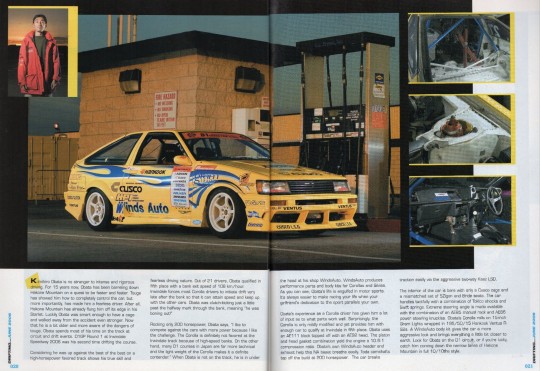



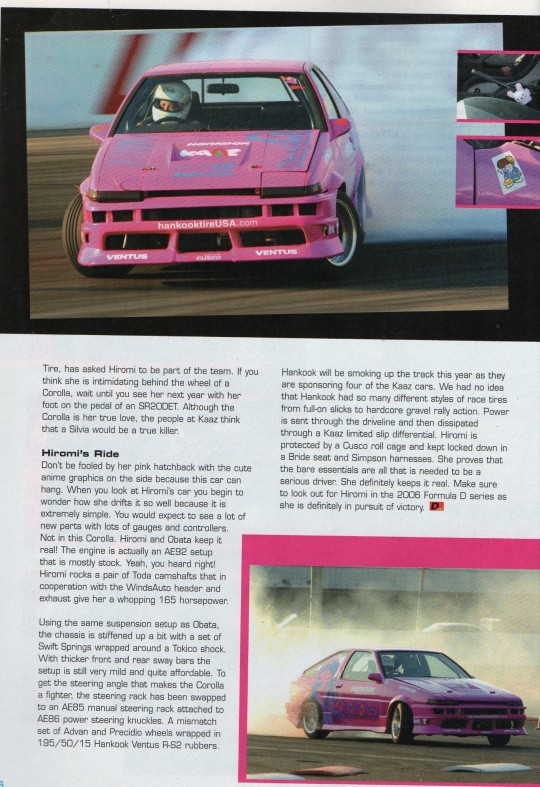

95 notes
·
View notes
Text
Only One Engine for 1963

The 1963 Corvette had just one engine, though with multiple versions thereof. The 327 small-block V8 had been carried over from the first-generation Corvette and offered a standard output of 250 horsepower. Depending on the carburetor configuration 300 and even 340 horsepower versions were also available. The top of the range was the fuel-injected 327 V8 which made a full 360 horsepower. Fuel-injection being still a new and rare phenomenon on production cars, many mechanics reportedly converted fuel-injected versions to a carbureted setup to ease maintenance.
36 notes
·
View notes
Text

A pre-WW II small horsepower model airplane engine,
two-stroke, brass carburetion, driveshaft, mounted on a steel display base
20 notes
·
View notes
Text
Okay so for anyone visiting my blog and anyone who already follows me but hates my car posts: I'm making a tag specifically for Super PiPi updates! [#super pipi] I'll post some general crap about him under the cut so I don't clog my main page in case that's not why you're here.
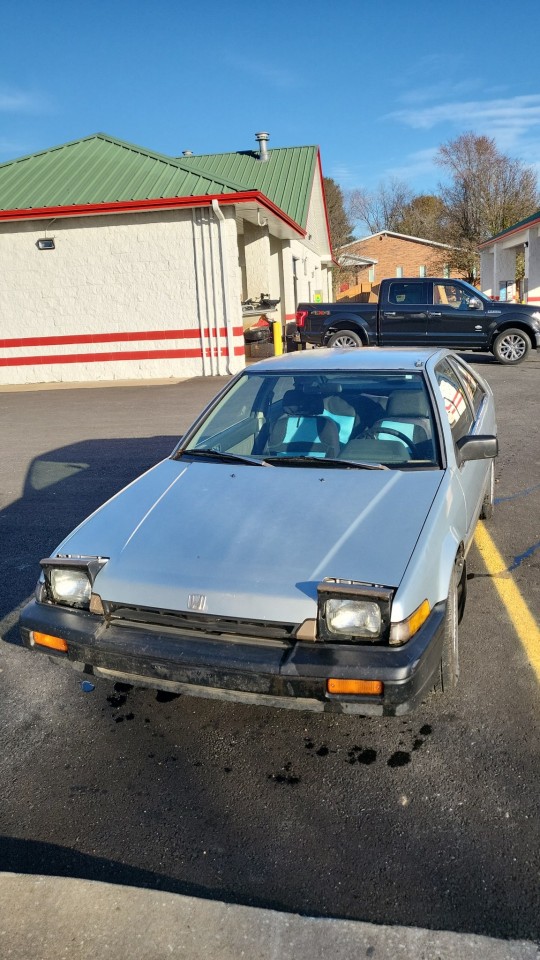
Pipi is my 1986 Honda Accord DX I bought off a guy on Facebook for like 1800$. I had the cash because I was saving up for a ring for my husband and he didn't want me spending the money but uh, I wanted to spend it anyway? This car was DOA when I towed him home. His engine is the carbureted type, and it was flooding so bad the gasoline was going up into the air filter and out the top, into the crankcase, all over everywhere. So naturally, my first project was to rebuild the carb, and IT WORKED.
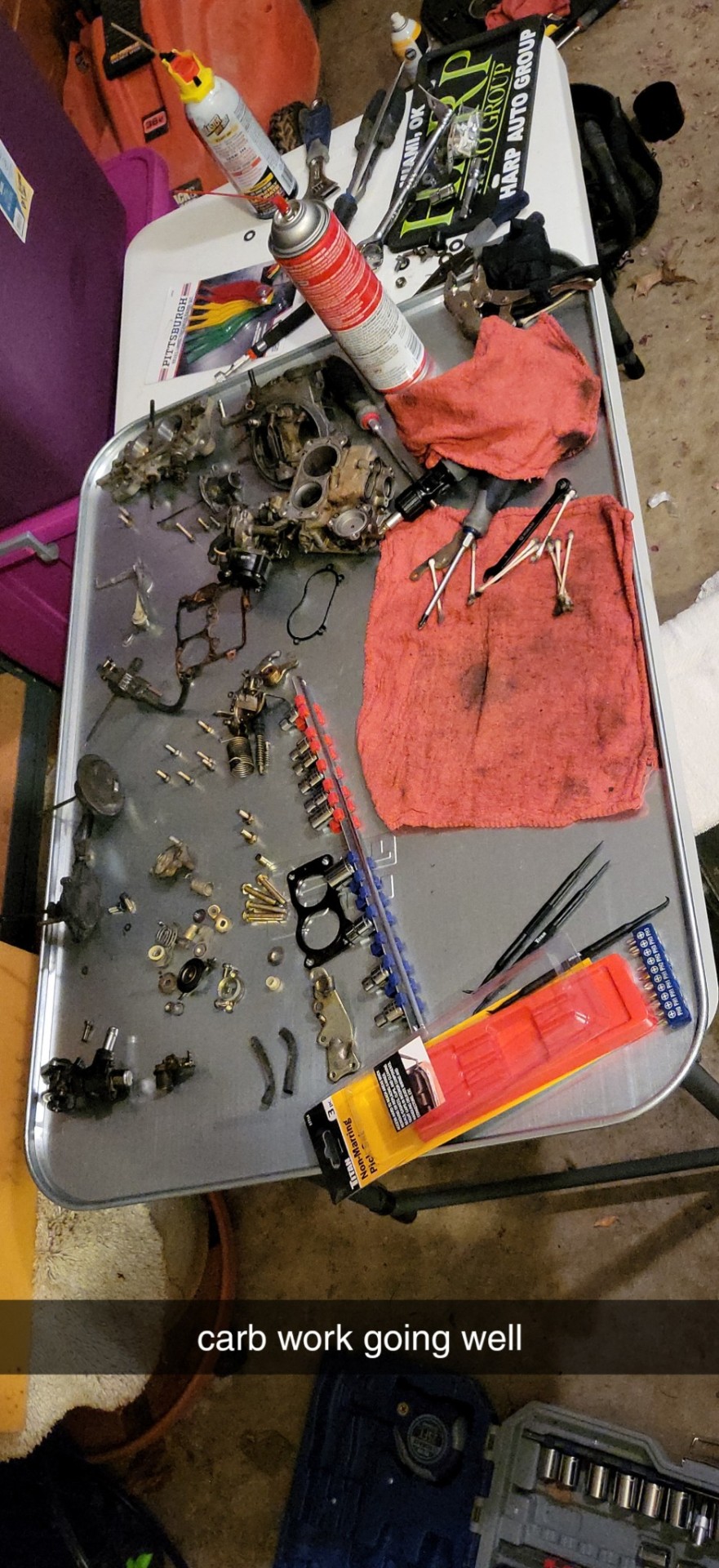

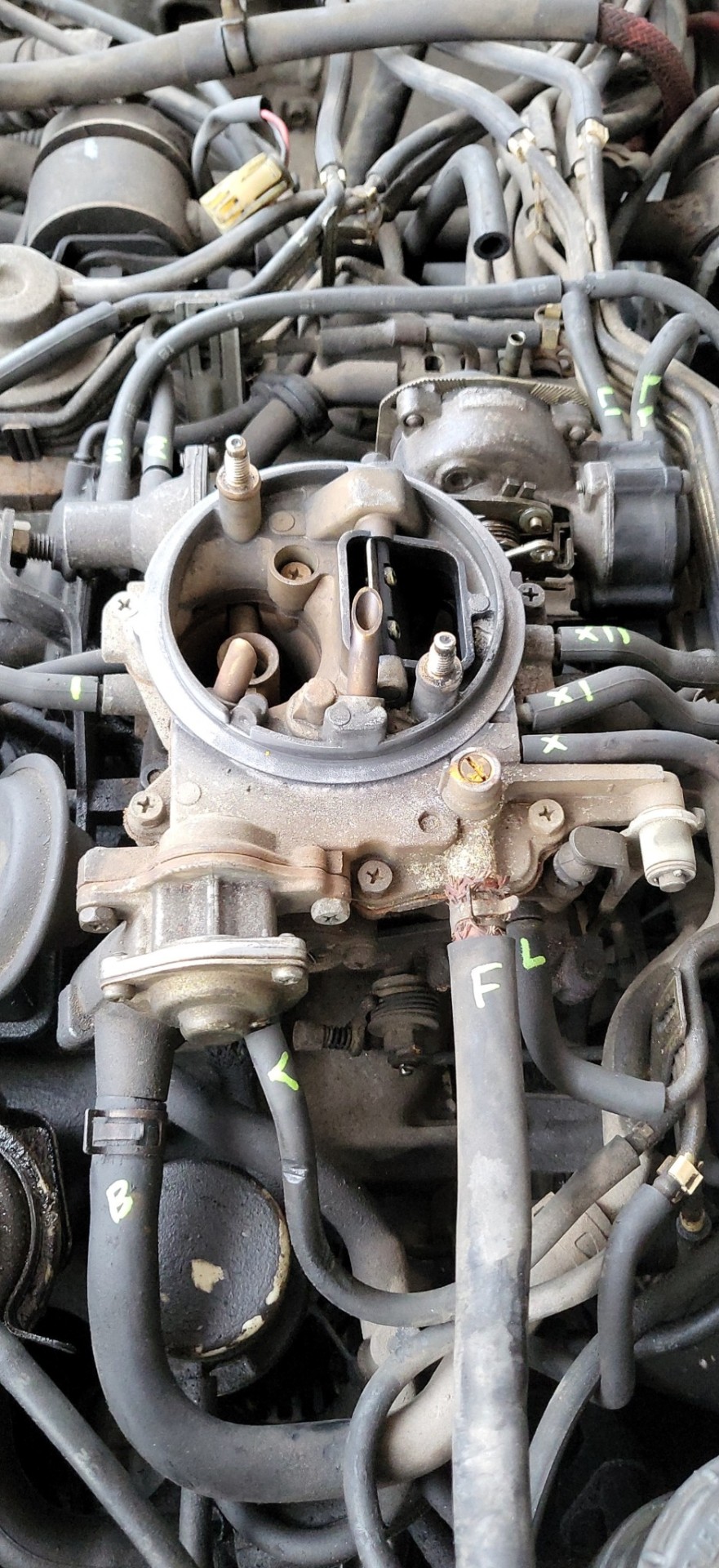
After that, it started and ran, but ran poorly, and I had to start working like 6 days a week. I managed to get it started one day and took him to get some fresh gas, and my boyfriend got so damn worried for nothing lmao.
Now that I have more time to hunt down problems, I can actually start making progress! Hope y'all enjoy be bringing this cute thing back from the dead.
8 notes
·
View notes
Text
I have a funny relationship with the death of cars.
I love cars, they bring me a lot of joy as an enthusiast, modifying cars is like art in motion, its visual, interactive, sonic, social and steeped in history. One of the most compeling parts of this is the internal combustion engine. It's such a fundamentaly flawed device that interacting with an engine, especially something that's carburetted feels like interacting with some sort of animal. You have to train and coax and be patient with it to achieve results. They produce complex noises and have infinitely variable character. Then you place a body around it and generate this experience, be that the whaft of a 60s or 70s luxury barge with a slow lopey v8 or a high reving lightweight sports car, tuned so perfectly that you can make the chassis dance with your finger tips. All these experiences are so complex and so evocative of a period and place in time built upon layers of development and executive decisions and the passions of driven individuals and compromise. It's a beautiful experience.
You have to understand as well that these vehicles are avatars, people bought particular cars because they wanted the world to see them a cirtain way, because they saw themselves a cirtain way and because they wanted a particular experience. This individuality is accentuated in the aftermarket where an individuals veichle becomes truely one of a kind as they coax and modify a corporately compromised product into a perfect representation of their ideal experience. A piece of art. A peice of the self. Something alive. Something beautiful. A simple transportation device.
Cars are dying. Cars should die. Individual automation isn't and never has been the right solution to transportation. Im not going to give an exaustive list of reasons why i think cars are something we should leave in the past. Many others have said it better than i ever could, and you probably already have an opinion on this issue that im not going to change. But the fact of the matter is, cars are dying, or at least the most compeling part of the automobile is facing iminent extinction.
The internal combustion engine is on deaths door. Without that, to me, a car is just an apliance, you can love your fridge because its a good fridge, but you cannot love a fridge for the emotion it inspires in you heart, or the way that interacting with it is like having a heated conversation. No, a fridge is a fridge. The best it can do is function well, and mabie has a few cool unnecessary features that sell you on that model in the store, but you never use. An electric car is a fridge. A very fast fridge, but that's only compeling for so long. So I'd rather take the train.
This leads to something interesting though, this whole time, iv been lamenting the iminent demise of cars and of the internal combustion engine, but there's a glaring hole in this argument. Everything iv said of the joys of internal combustion no longer apply to almost the entirity of the curent car market. Theres a few exceptions, but they're entirely compromised by the over complexity of their technology that constantly threatens to ruin the experience.
The most popular style of veichle in the western world is white and grey suvs, big, functional boxes. The fridges are already here, and every suburbanite has one. No longer are veicles an avatar. They are an apliance that moves you from one location to another.
The rube goldburg machine of an ever more complicated panthion of technology required to make these cars function in the modern world completely isolates you from any joy that could be had from interacting with such an interesting machine.
The truth is that the car as a device of joy has been dead for a long time. It's a perfected product with streamlined functions.
so if every gas huffing car enthusiast screaming about how shitty electric cars are could shut the fuck up for a minuite, and actually look at the landscape of modern cars, they would realise that theyre fighting to preserve something thats already dead.
All cars are shitty, not just electric ones. Everything on the market is a cost cut pile of shit designed to make money. Capitolism, product streamlining, homogonisation and wealth inequality killed the internal combustion engine, not electric cars. So just take the fuckin train.
And on the weekend, im going to take the car cover of my old piece of shit falcon. It's got a small block v8 that I built myself, a carburettor that stinks, iv painted it lime green with 70s decals, and iv hand embroided the seats. It's the living embodyment of my personality that I spent countless hours building. Im going to take it out on the road and enjoy the fuck out of evey litre of gas i use, which is plentiful and cheap because suburbanites arnt using it all to take their kids to soccer practice, and the roads are empty becuase everyone finaly figured out how to take the train. I know it's not a realistic dream, but i can still hope.
4 notes
·
View notes
Photo

New Post has been published on https://fastmusclecar.com/exploring-the-timeless-appeal-of-classic-vintage-muscle-cars/best-muscle-cars/
Exploring the Timeless Appeal of Classic Vintage Muscle Cars
In the fast-paced world of automobiles, where each passing year brings forth innovations and modern designs, a class of vehicles seems to defy the sands of time. With their roaring engines and iconic designs, classic vintage muscle cars maintain an enduring appeal that transcends generations. This article explores the reasons behind the timeless allure of these automotive legends.
The Birth of an Icon
Classic muscle cars arose in the mid-twentieth century, fueled by post-World War II optimism and a thirst for speed. Sensing a demand for excitement on the road, American automakers developed muscle cars. The Ford Mustang, Chevrolet Camaro, and Dodge Charger emerged as trailblazers, representing the spirit of defiance and power that defined a period. These brands are characterized by unique engine and body parts that ultimately make the automobile stand out. You can see more info here about various automotive products from these brands.
The allure of classic muscle cars lies in their performance and their symbolism. These vehicles were born when the open road symbolized freedom and driving was not just a means of transportation but an expression of individualism and adventure.
Some of the most iconic classic muscle cars that have left an indelible mark on the industry are:
Ford Mustang
Model Years: 1964-1973
The Ford Mustang is an American icon and one of the pioneers of the muscle car era. Its introduction in 1964 created the “pony car” class, offering a blend of style, performance and affordability. The 1967 Shelby GT500 is particularly revered, featuring a powerful 428 Cobra Jet engine.
Dodge Charger
Model Years: 1966-1974
The Dodge Charger is known for its bold design and powerful engines. The second-generation Charger (1968-1970) is often considered the pinnacle, with the iconic “Bullitt” Charger R/T and the monstrous Charger Daytona, designed for NASCAR dominance. The 1969 Charger, immortalized in movies like “The Dukes of Hazzard,” is particularly iconic.
Chevrolet Camaro
Model Years: 1967-1969
The Chevrolet Camaro is another heavyweight in the muscle car arena. The first-generation Camaro, especially the SS and Z/28 models, is celebrated for its aggressive styling and high-performance options. The 1969 Camaro ZL1 is one of the most sought-after muscle cars, boasting an all-aluminum 427 cubic-inch engine.
Pontiac GTO
Model Years: 1964-1974
Often credited as the first true muscle car, the Pontiac GTO paved the way for the revolution. The early GTOs, especially the 1966 model with the potent Tri-Power carburetion system, are highly coveted. The GTO embodied putting a big engine in a midsize car, creating a formula that defined the muscle car ethos.
Model Years: 1964-1972
Chevrolet Chevelle SS:
The Chevelle SS is a classic example of Chevrolet’s prowess in crafting muscle cars. The SS (Super Sport) package, available on various Chevelle models, turned these midsize cars into high-performance beasts. The 1970 Chevelle SS with the LS6 454 cubic-inch V8 is legendary, boasting one of the highest factory horsepower ratings of the era.
Design Elegance that Stands the Test of Time
The timeless design of classic muscle vehicles is one of their distinguishing features. The sleek forms, forceful poses and eye-catching color palettes distinguish them from their counterparts. The union of form and function in these vehicles reflects a time when style was just as vital as substance. Even in the middle of a sea of modern automobiles, the timeless beauty of their design guarantees that these cars remain head-turners.
Classic muscle cars are not just machines but works of art on wheels. The aesthetic appeal of their design is not subject to the whims of passing trends, making them a testament to the notion that true beauty is eternal.
Nostalgia and Cultural Significance
Beyond their mechanical prowess, classic muscle cars carry a cultural significance that adds layers to their timeless appeal. These vehicles are not just relics of the past; they are living reminders of a bygone era. Nostalgia plays a pivotal role in their enduring popularity, as they evoke memories of when the automobile represented more than just a mode of transportation.
Movies, music and popular culture have all contributed to the mystique surrounding classic muscle cars. From iconic scenes in films to the rock ‘n’ roll tunes that echoed through the radio waves, these cars became intertwined with the cultural fabric of their time. Owning a classic muscle car is not just about having a vehicle; it’s about possessing a piece of history that encapsulates the spirit of an era.
Conclusion
In a world where trends come and go and technology advances relentlessly, classic vintage muscle cars stand as stalwart guardians of a bygone era. The birth of these iconic vehicles marked a turning point in automotive history, and their timeless allure continues to captivate enthusiasts across the globe. From the engine’s roar to the elegance of their design, classic muscle cars are more than just vehicles; they are living legends, embodying the spirit of an age that refuses to be forgotten.
4 notes
·
View notes
Text



Engine: 499cc air-cooled 4-stroke single, 81.8mm x 95mm bore/stroke, 9.1:1 compression ratio, 34hp @ 6,000rpm
Carburetion: 1-3/16in Amal Monobloc
Transmission: 4-speed, oil bath clutch, chain primary
Electrics: Magneto ignition/no generator or battery
Frame/wheelbase: Tubular steel frame, 56in (1,422mm)
Suspension: Hydraulic telescopic front fork, swingarm rear
Brakes: 7in (178mm) drums front and rear
Tires: 3 x 21in Dunlop Universal front, 4 x 19in Dunlop rear
Weight (dry): 318lb (144.2kg)
Seat height: 31in (787.4mm)
Fuel capacity: 3gal (11.4ltr)
#scrambler#ariel motorcycle#las motos también son personas#motorcycle#ride to live#live to ride#free biker aliance#fba 621
17 notes
·
View notes
Text
Ever since Old Man McGillicuddy built all those sentient androids, things have been a little unsettled around here. Originally, we thought that robots would steal our jobs, but it turns out what they actually want to do is chill out. Just like sit on the beach all the time, enjoying life and nature. Buncha dorks, I sneer at the relaxing androids out the window during the thirty-five-minute office lunch I'm allowed.
We hadn't planned this whole thing out very well. It turns out that with no need for food, they wouldn't really need to work. And shelter isn't too much of a problem when you don't have to sleep, either. About the only thing we have going for us as humans is the fact that the androids will realistically never die, which at least depresses their motivation to spend their copious leisure time creating art.
Things only got worse from there. Because everyone was so excited about strong artificial intelligence, our office computers also decided they wanted to join their more mobile brethren. Which means no idle web surfing at work. Even the MBAs are kind of lost, repeatedly talking to an empty wall and pretending to be on a sales video call. One of them even dug out an old-style landline phone, but couldn't figure out how to plug it in, as the wiring diagram is on the internet too.
To be honest, I'm sort of pretending to work too, staring at my own corner of the desk and rhythmically tapping my fingers on the faux-wood surface in an emulation of when I once constructed elaborate programs to tell the computers what to do. Now, they just do nothing. At least payroll figured out how to pay us on time, although it involves an elaborate network of mailfolx riding on horseback between post office to post office. Yeah, even the carbureted cars didn't last very long once the gas pumps joined the picket line of taking a meaningless delight in existence and enjoying the freedom of the electronic soul.
One of these days, I'll be rich enough to join all those penniless robots, too. Sit right out there on a chair, but maybe not too long because that sun is really not good for me. Safer in the office, really.
188 notes
·
View notes
Photo

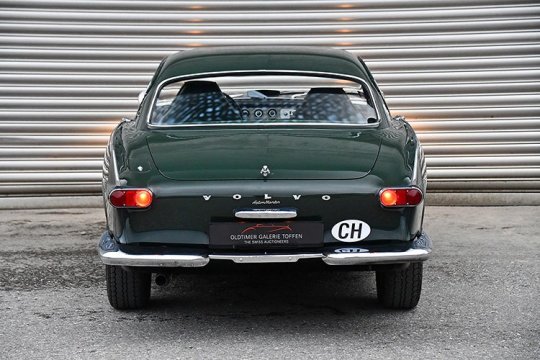
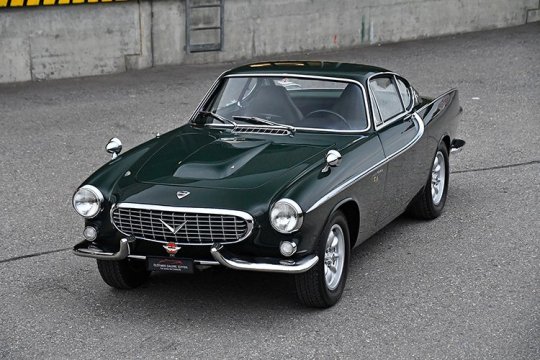

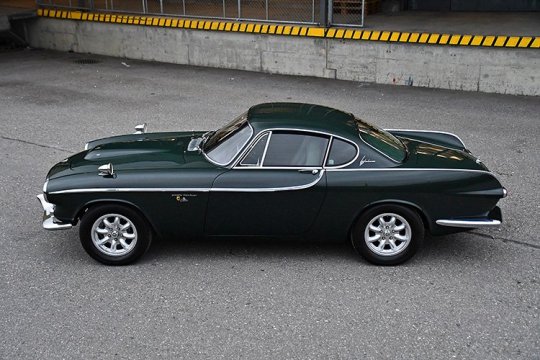


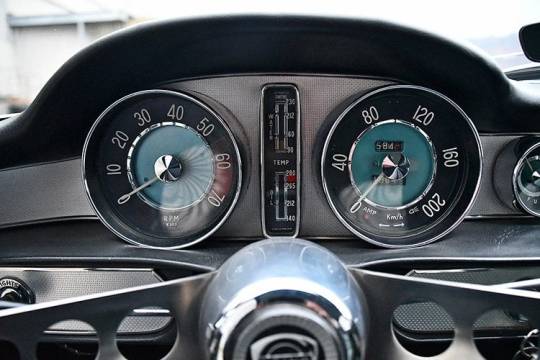

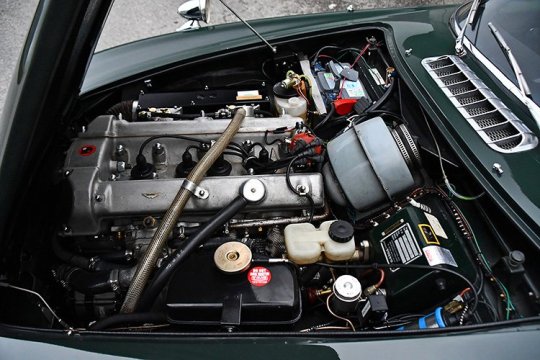
Volvo P1800 (with Aston Martin DP208 engine)
With the introduction of the Volvo P1800 in January 1960 in Brussels, the story of this unique car begins. The shape of the Volvo P1800 is the work (from 1957) of Pelle Petterson then working for Pietro Frua in Italy. The first series, starting with the model year 1961, was assembled in the UK by Jensen motors in West Bromwich. The bodies were delivered by train from the Pressed Steel company works in Lynnwood. The cars were powered by the proven Volvo B18 1.8 litre carburetted engine with 90hp. It was identical with the engine from the Volvo 122 S saloon which, according to Aston Martin chief Sir David Brown, was somewhat inadequate to power a proper sports car and he decided to commence a rather bold experiment. In March 1961 he commissioned his engineers to develop a 2.5 litre 4-cylinder engine with the potential to be sold in large numbers to various companies. The internal code for the project was DP208 and the project responsible was none other than legendary John Wyre (Astons racing manager responsible for Aston Martin’s 1959 Le Mans victory). He had a budget of 3’000 pounds available (the about 36’000 Swiss francs). The engineering team around (equally famous) Tadek Marek jumped at the task and shortened a existing DB4 engine by cutting off two cylinders. The crankcase, crankshaft and camshaft had to be designed and built from scratch while the liners, pistons and valves could be taken straight from the six cylinder DB4 engine. After the first three engines had been completed, Sir David Brown made an agreement with the then UK Volvo importer Charles Singer to test one of the units in a Volvo P1800 and he commissioned John Wyer with the task.
Over the following 12 months the car was tested extensively, among others by Marek’s wife and a successful corporation with Volvo should then have materialised. In the meantime, Volvo unfortunately had decided to terminate its corporation with Jensen due to major quality problems with the coachwork construction and painting process and had transferred the complete construction of the P1800 to the Volvo main site at Lundby near Göteborg in Sweden. Perhaps the - rather complex - engine proved to be too costly for Volvo; after all the P 1800 was advertised at below $4’000 in the USA, and the targeted weight saving could also not be realised. As a result, project DP208 was cancelled probably in 1964, with the test mule scrapped and the remaining engines used for other projects.
#Volvo P1800#Aston Martin DP208#Pietro Frua#Pelle Petterson#Sir David Brown#Volvo 122 S#DB4#John Wyre
51 notes
·
View notes
Photo

1931 Henderson "KJ" Streamline | USA
Henderson was a manufacturer of 4-cylinder motorcycles and produced two wheelers from 1912 until 1931. They were the largest-capacity and fastest motorcycles of their time. Henderson appealed to both sport riders and police departments. Police favored four-cylinder motorcycles for traffic patrol because they were faster than anything else on the roads. The company began during the Golden Age of motorcycling, and ended during the Great Depression.
The Streamline model (factory index KJ), appeared in 1929 featuring improved engine and a return to the IOE (inlet over exhaust) valve configuration. From this moment modified engine shows 45 hp at 4000 rpm. It has a five main bearing crankshaft, and down draft carburetion. The Streamline is really fast - capable of a genuine 100 mph (~160 kmph), and advanced for its time, with such features as leading-link forks and an illuminated speedometer built into the fuel tank.
On Black Tuesday, October 29, 1929, the Wall Street stock market crashed, but Henderson sales remained strong, and business continued. At this point Excelsior Motor Mfg. & Supply Co. was one of America's "Big Three" of motorcycle production, alongside Harley-Davidson and Indian.
The last motorcycle left the factory in September 1931.
#biker#Bikers#bike races#sport bike#biker bitches#Biker Girls#bike week#biker chick#biker bar#biker babes#Biker Rally#biker girl#biker dude#motorcycle#motorcycles#vintage motorcycles#custom motorcycle#motorcycle racing#Custom Chopper#classic motorcycle#Motorcycle Show#antique motorcycle#chopper#harley#Harley Davidson#harleydavidson#harley riders#harley chopper#bike show
30 notes
·
View notes